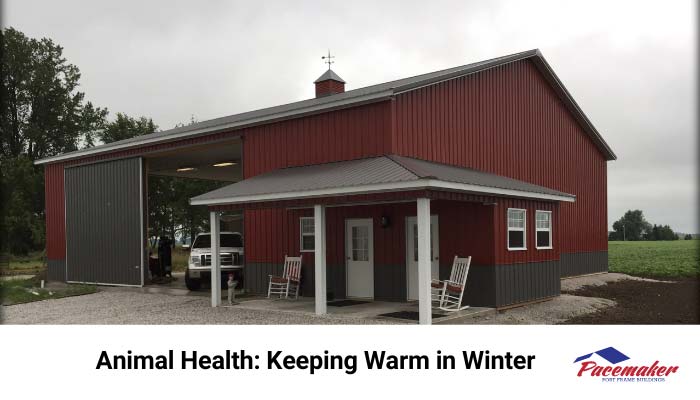
A newly constructed post frame barn can look great, but have you created a healthy atmosphere for the animals living there? Are you keeping warm while you are inside?
In colder climates, it is vital to consider how to keep your animals and yourself healthy and comfortable. Animals generate a lot of their own heat. People who spend lengthy periods in your barn will also need to stay warm. Use these tips to ensure your post frame structure is comfortable for animals and humans all year.
Position the Barn for Prevailing Winds
If you are planning a new barn, start by facing the entrance away from the prevailing winds and nasty weather. Usually, this may mean facing south or east, making sure that the entrance is on the leeward side. This will help to protect it from the most common oncoming wind and storms.
Add Overhangs to Prevent Snow Buildup
In areas where excessive snow is likely, make sure the overall structure is heavily reinforced to eliminate the chance of overload and collapse. Your post frame expert will advise the best options for your design, use, and location.
In heavy snow areas, adding a minimum 4-foot overhang to the entrance and exit prevents snow buildups in the doorway. This reduces the problem of potential blockage while providing room to maneuver into and out of the barn.
Winterize Water Lines and Troughs
Making sure water is always available is critical for animal health. You will need to wrap any water lines appropriately for the minimum temperatures in your location. This will make sure flowing water is always available in the post frame building for your horses or livestock.
Apply Insulation
The 6 to 10-foot spacing of the vertical posts in post frame buildings is ideal for maximizing the efficiency of any insulation. Ideally, your insulation plan should start during the planning phase to achieve maximum efficiency and economy. Planning your insulation can make a big difference in its effectiveness and can reduce the energy cost of warming your barn.
If you are planning for an office or entertainment area in the building, consider adding foundation insulation.
The thickness of your insulation will depend on your location and needs. In colder areas, consider a material that is extra thick. For example, a two-inch foam insulation rated at R-16 provides three times the insulation value of the steel outer wall. For even more excellent protection and flexibility, you may consider a 6-inch material that gets covered by interior drywall or other materials.
Be sure to follow the guidelines from your window and door manufacturers to prevent air and water from infiltrating the building through these openings.
Plenty of Ventilation
Fresh air is necessary in all seasons. Vented eaves admit the air while it warms and rises to exit flow-through ridge vents in the roof. This process is essential to minimize moisture and eliminate the stuffiness that tends to accumulate.
Your professional post frame builder can advise you on the best ways to ventilate depending on your climate, animals, location, and design aesthetics.
Radiant Floor Heat
Horses do not need radiant floor heating, but people typically prefer it. Adding radiant floor heating for part of the building where people frequent can be beneficial. Discuss your current and future ideas for the post frame barn with a building expert since adding floor heating at the start is much cheaper.
Check with Pacemaker Post Frame Buildings
Depending on your location, there are many strategies for dealing with severe weather. The professionals at Pacemaker Post Frame Buildings in North Webster, Indiana, have experience building in Northern Indiana, Northwest Ohio, and Southwest Michigan. These professionals are exposed to all types of severe winter weather and summer heat and can advise the best course of action for your animal needs.
Check out many of Pacemaker’s completed projects by visiting their website’s Gallery.
You can speak directly to one of the Pacemaker professionals by calling them at 888-834-4448 or using the Contact Us form.
